In the Adriatic Sea, a fair number of fish of the Perciformes order are represented by one or two species of the families, or they may even be completely monotypic species.
Dealing with each family in a separate article is an unattainable luxury. So, adriaticnature compiled the “poor” relations of representatives of the Perciformes order (or the Percoidea superfamily to be more precise), inhabiting the Adriatic Sea, in one article.
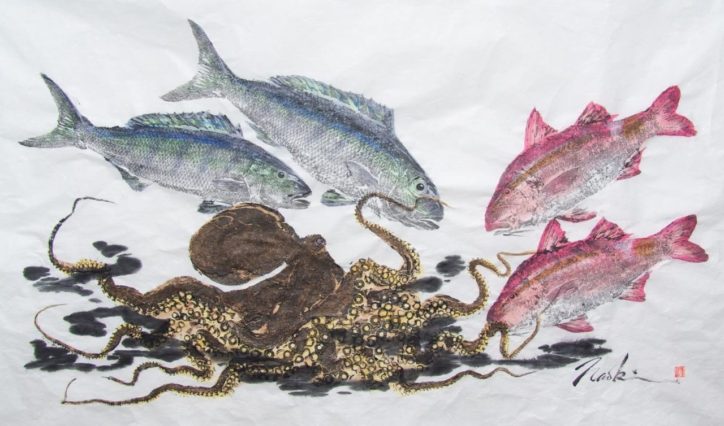
(Gyotaku by Naoki Hayashi. atlasobscura.com)
The Apogonidae (cardinalfishes) family comprises about 370 species of medium-sized fish. Most of them aren’t longer than 10 centimeters. These are mainly sea, vividly colored fishes, which are widely spread in the tropical waters of the Indian, Pacific and Atlantic Oceans and inhabit the areas near coral reefs. They have nocturnal habits and hide in caves or crevices of reefs during the day. They feed on zooplankton. Only one representative of the family is found in the Adriatic Sea.
Cardinal fish or Mediterranean cardinalfish (Apogon imberbis).
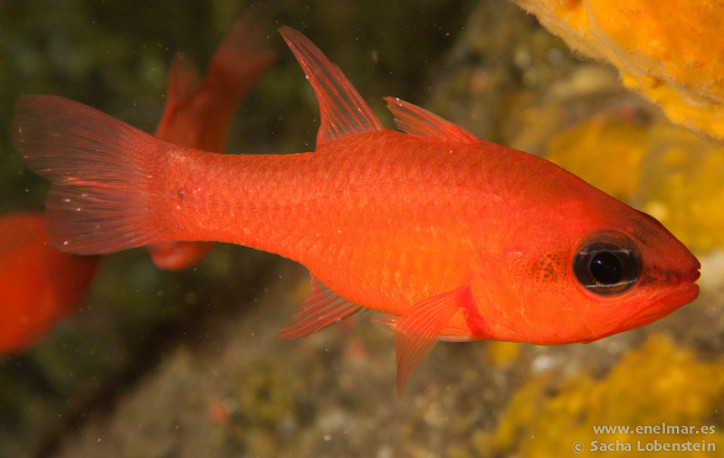
(Cardinal fish. Photo by © Sasha Lobenstein. enelmar.es)
It inhabits the depth of 10-200 meters. The maximum recorded length is 15 cm. It prefers to swim close to the muddy and rocky bottom. It hides in underwater caves and other shelters during the day. It has nocturnal habits. These fish get together in small schools. It feeds on invertebrates and small fish. It is a permanent inhabitant of the Adriatic Sea.
Epigonidae (deepwater cardinalfishes) is a small family that comprises about 35 deep-sea fish species that inhabit the Atlantic, Indian and Pacific Oceans, as well as the Mediterranean Sea. The largest representatives of Epigonidae are 75 cm long, most of them aren’t longer than 20 cm. The maximum depth, at which species of the Epigonidae family have been found, is about 3,000 meters. Two representatives of the family are found in the Adriatic Sea:
Pencil cardinal (Epigonus denticulatus).

(Pencil cardinal. Photo by © Brandi Noble. fishbase.org)
It inhabits the depth of 130-830 meters, more often – 300-600 meters. The maximum recorded length is 20 cm. It feeds on invertebrates and small fish. It has been found several times in the southern part of the Adriatic Sea.
Black cardinal fish (Epigonus telescopus).
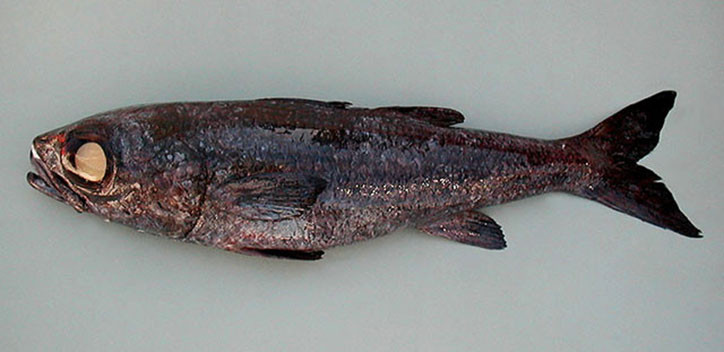
(Black cardinal fish. Photo by © Pedro Niny Duarte(c)ImagDOP. fishbase.org)
It is a deep-sea species. It inhabits the depth of 75-1,200 meters, usually – 300-800 meters. It prefers to swim close to the sandy and oozy bottom. The maximum recorded length is 75 cm, specimens up to 55 cm long are more common. It feeds on small fish and invertebrates. It has been found several times in the southern part of the Adriatic Sea.
The Bramidae (pomfrets) family got its Latin name due to the outward resemblance to common bream (Abramis brama), the famous freshwater fish of the Cypriniformes order. It comprises about 20 sea fish species, inhabiting the tropical, subtropical and temperate waters of all oceans. They have pelagic habits. Usually, they aren’t longer than 50-60 centimeters, however, the largest species of the family may be a meter long and weigh about 6 kilograms. All Bramidae are predators that feed on fish and crustaceans. They are very popular in national cuisine of South Asia. Only one representative of the family is found in the Adriatic Sea:
Atlantic pomfret (Brama brama).

(Atlantic pomfret. Photo by © Karla Otta. biolib.cz)
It inhabits the depths of up to 1,000 meters, usually – up to 200 meters. It is a bathypelagic species. These fish get together in small schools. Sometimes, they swim close to the shore, chasing the food. The maximum recorded length is 100 cm, specimens up to 40 cm long are more common. The maximum weight is 6 kg. It feeds on small-sized fish, cephalopods, and crustaceans. It is a permanent rare inhabitant of the Adriatic Sea. It is more often found in its southern part.
The Callanthiidae (splendid perches) family comprises about 15 species of medium-sized fish that inhabit the eastern part of the Atlantic Ocean, including the Mediterranean Sea, the Indian and Pacific Oceans. They are vividly colored medium-sized fish, the length of which rarely exceeds 25 centimeters. Only one representative of the family is found in the Adriatic Sea:
Parrot seaperch (Callanthias ruber).

(Parrot seaperch. Photo by © Francesco Costa. fishbase.org)
It inhabits the depth of 50-500 meters. It prefers to swim close to the rocky and oozy bottom, often hides in underwater caves. The maximum recorded length is 60 cm. It is usually about 17 cm long. It feeds on crustaceans and small fish. It is a permanent inhabitant of the Adriatic Sea.
Coryphaena is the only genus of the Coryphaenidae (dolphinfishes) family that comprises two species, namely: little dolphinfish and common dolphinfish. It is one of the fastest growing sea fishes inhabiting the Atlantic, Pacific and Indian Oceans. The life expectancy of dolphinfishes is about 4-5 years. They have an elongated body compressed laterally. Due to this fact, they can move at the speed of up to 90 km/h in water. They are tinged with golden, males differ from females with a high, almost vertical, forehead. They are omnivorous predators feeding on fish, squids, crabs and zooplankton. Colloquially, dolphinfishes are increasingly called mahi-mahi, which came in English from their Hawaiian name, which can be translated as “very strong”. Only one representative of the family is found in the Adriatic Sea:
Common dolphinfish or mahi-mahi, or dorado (Coryphaena hippurus).
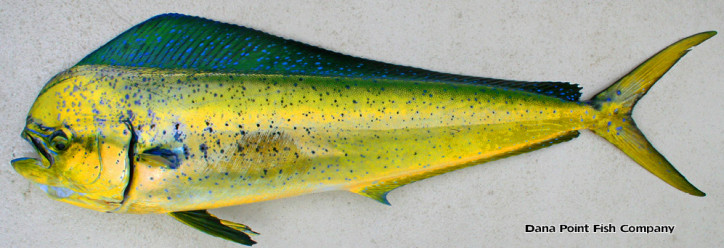
(Common dolphinfish. Photo © danapointfishcompany.com)
It inhabits the depths of up to 85 meters. It is a pelagic schooling species. It often swims close to the shore, when the water gets warmer. The maximum recorded length is 210 cm, specimens up to 100 cm long are more common. The maximum weight is 40 kg. Life expectancy is about 4 years. It feeds on fish, crustaceans and squids. It is a permanent inhabitant of the Adriatic Sea, which is found more often in its southern part.
Echeneidae (remoras or suckerfish) is a family comprising eight fish species. Their length varies from 17 to 110 centimeters. A distinctive feature of Echeneidae is a sucker on the head, which was formed of the displaced dorsal fin during the evolution. They stick to large sea fish, mammals, as well as turtles and the bottoms of ships, but, at the same time, they swim quite well on their own. Three representatives of the family are found in the Adriatic Sea:
Live sharksucker (Echeneis naucrates).
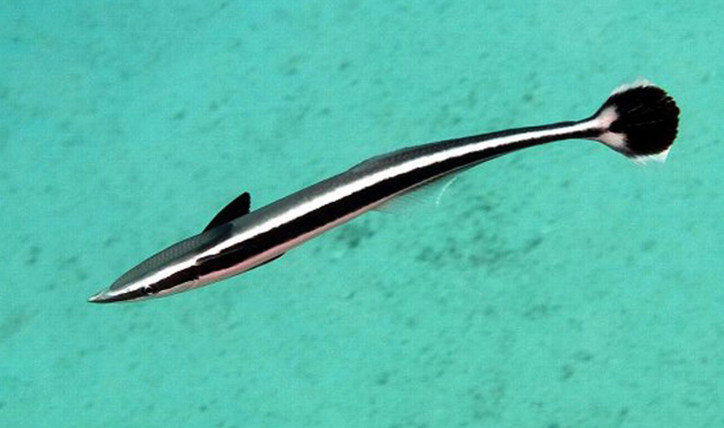
(Live sharksucker. Photo by © Joseph De Vroe. fishbase.org)
It inhabits the depth of 1-85 meters and prefers to swim near the coast. It sticks to sharks, rays, large bony fishes, and turtles temporarily, but they are often found free floating as well. The maximum recorded length is 110 cm, specimens up to 70 cm long are more common. The maximum weight is 2.3 kilograms. It feeds on small fish, squids, crabs, food leftovers that come with a large fish and parasites from its body. It enters the Adriatic Sea together with its “masters”.
Whalesucker (Remora australis).

(Whalesucker. Photo by © Hamid Badar Osmany. fishbase.org)
It is a pelagic species. It sticks to the body of whales and dolphins. The maximum recorded length is 76 cm. It feeds on the metabolic by-products of its “masters”. It is a rare inhabitant of the Adriatic Sea that enters it together with its “masters”.
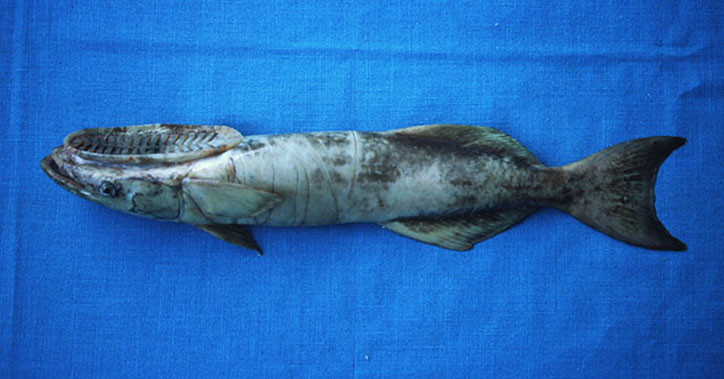
(Shark sucker. Photo by © Philippe Béarez. fishbase.org)
It is a pelagic species. It sticks to the body of sharks and other large fish, as well as turtles, and it is found free floating as well. The maximum recorded length is 86.5 cm, specimens up to 40 cm long are more common. The maximum weight is 1.1 kg. It feeds on small parasitic crustaceans from the body of the “master”. They enter the Adriatic Sea together with their “masters”.
Moronidae (temperate basses) is a family that may sound unfamiliar to you. However, it comprises many well-known fish species that have come to many other languages with their English names. It comprises two fish genera, namely: Dicentrarchus, with two representatives inhabiting the eastern part of the Atlantic Ocean, including the Mediterranean Sea, and Morone, with four representatives inhabiting the water bodies of North America, the most famous of which is striped bass (Morone saxatilis) (this popular sport fishing target is found on the side of the Atlantic Ocean).
Until recently, the Lateolabrax genus, which comprises two fish species that are popular in fishing, was included in the Moronidae family as well. These are Japanese seabass (Lateolabrax japonicas), or Suzuki (鱸) in Japanese and blackfin seabass (Lateolabrax latus). Now, Lateolabrax is considered to be a separate family of Lateolabracidae.
Two representatives of the family are found in the Adriatic Sea:
European seabass (Dicentrarchus labrax).

(European seabass. Photo by © Roberto Pillon. naturamediterraneo.com)
It is a sea inshore fish species that inhabits the brackish and fresh water as well. It prefers to swim at the mouths of rivers, it may also swim upstream. The maximum recorded length is 103 cm, specimens up to 50 cm long are found. The maximum weight is 14 kg. It feeds on fish. It is a permanent inhabitant of the Adriatic Sea. It may swim upstream for considerable distances to get into the rivers flowing into the sea.
Spotted seabass (Dicentrarchus punctatus).
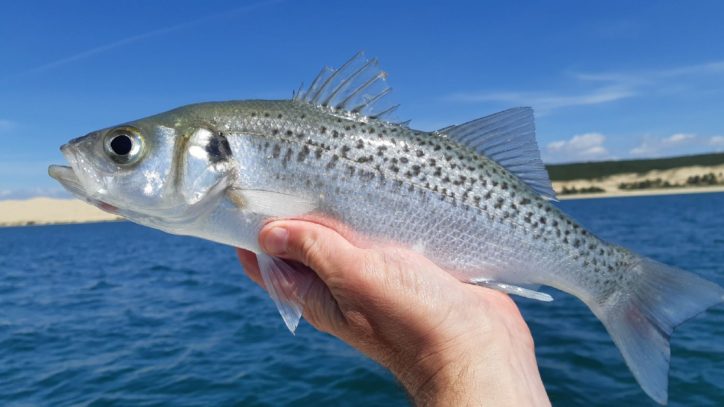
(Spotted seabass. Photo © fishfriender.com)
It is a sea inshore fish species, which is often found at the depth of over 30 meters. It prefers to swim close to the river mouths. In winter, it swims to deeper areas of the sea. The maximum recorded length is 70 cm, specimens up to 30 cm are more common. It feeds on shrimps, mollusks, and fish as well. It is an extremely rare inhabitant of the southern part of the Adriatic Sea.
The Pomatomidae (bluefishes) family is represented by the only living species, that is bluefish (Pomatomus saltatrix). It inhabits all the temperate and subtropical waters of the World Ocean, with the exception of the North Pacific. It is a popular target of sport fishing. It is a pelagic predatory fish, which prefers to chase the prey near the surface.
Bluefish (Pomatomus saltatrix).

(Bluefish. Photo by © Rudie H. Kuiter. portphillipmarinelife.net.au)
It inhabits the depths of up to 200 meters. It often swims near beaches and rocky capes, river mouths. It is a schooling species. In winter, they migrate close to warm currents; in summer, they prefer to swim in cool waters. The maximum recorded length is 130 cm, specimens up to 60 cm long are more common. The maximum weight is 14.4 kilograms. It feeds on fish, crustaceans and cephalopods. It is a permanent inhabitant of the Adriatic Sea.
The Sciaenidae (drums or croakers) family comprises about 275 fish species that inhabit fresh, salty and brackish temperate and tropical waters of the seas and oceans. They are most widely spread in large rivers of Southeast Asia, northeast part of South America, the Gulf of Mexico and the Gulf of California. The sizes of adult fish of different species vary from 20 to 230 centimeters. Most Sciaenidae are bottom predators that feed on invertebrates and small fish. Three representatives of the family are found In the Adriatic Sea:
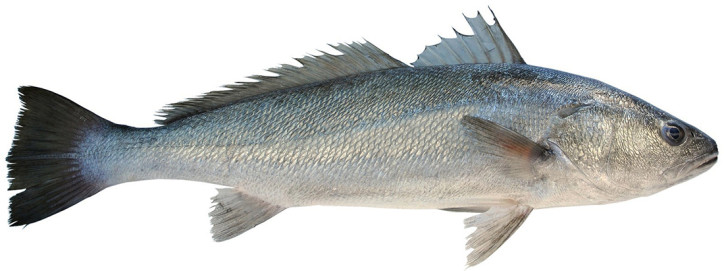
(Meagre. Photo © islasur.es)
It is an inshore species. It inhabits the depth of 15-300 meters. It often enters bays and lagoons, approaches river mouths. The maximum recorded length is 230 cm, specimens up to 150 cm long are more common. The maximum weight is 103 kilograms. It feeds on fish and crustaceans. It used to be a widely spread fish species. Nowadays, it is a very rare inhabitant of the Adriatic because of overfishing. It is more often found in the southern part of the Adriatic Sea. Attempts are being made to restore the population by growing juveniles in fisheries.

(Brown meagre. Photo by © entitu. flickr.com/photos/entitu)
It inhabits the depth of 1-200 meters. It prefers to swim close to the sandy and rocky bottom, often approaches the mouths of rivers. It is active at dusk and night. The maximum recorded length of 70 cm, specimens up to 28 cm long are more common. It feeds on crustaceans and fish. It is a permanent rare inhabitant of the Adriatic Sea.
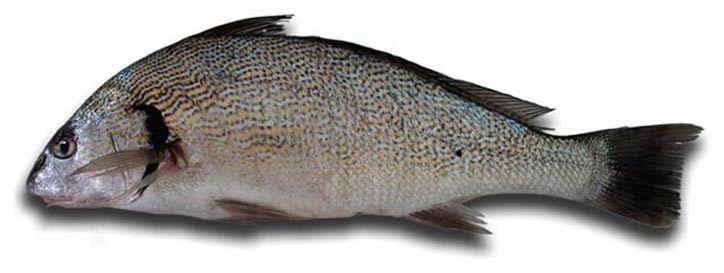
(Shi drum. Photo by © A.M. Arias. ictioterm.es)
It inhabits the depths of up to 100 meters, prefers to swim close to the rocky and sandy bottom, often near the river mouths. The maximum recorded length is 73 cm. Specimens up to 40 cm long are more common. It feeds on bottom invertebrates. It is a permanent inhabitant of the Adriatic Sea. It is more often found in its northern part, along the coast of Italy and on the border with the Ionian Sea.
The Mullidae (goatfishes) family comprises about 75 species, which are widely spread around the world and inhabit tropical, subtropical and temperate sea waters. In most cases, it is small fish, up to 20-30 centimeters long. Parupeneus barberinus is the largest fish of the family. It inhabits the Indo-Pacific region, growing up to 60 centimeters long. All Mullidae have chemoreceptor barbs at the bottom of the head. Fish search for food at the bottom with their help. They change color depending on the color of the bottom and in case they are taken out of the water. They feed on worms, crustaceans, mollusks and other small invertebrates.
Two representatives of the family are found in the Adriatic Sea:
Red mullet (Mullus barbatus barbatus).
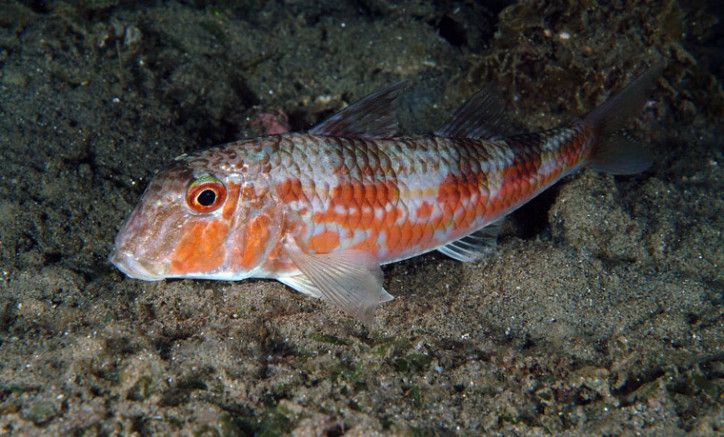
(Red mullet. Photo by © Stefano Guerrieri. naturamediterraneo.com)
It inhabits the depth of 10-328 meters, usually – 100-300 meters. It prefers to swim close to the pebble, sandy and oozy bottom. The maximum recorded length is 33.2 cm, specimens up to 20 cm long are more common. The maximum weight is 680 grams. It feeds on small bottom crustaceans, worms, mollusks and small fish. It is a permanent inhabitant of the Adriatic Sea.
Surmullet (Mullus surmuletus).
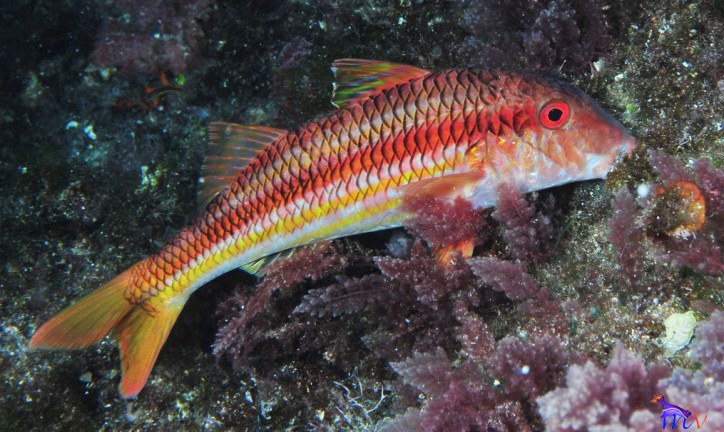
(Surmullet. Photo by © Miguel Villena. flickr.com/photos/79091085@N03)
It inhabits the depth of 5-409 meters. It prefers to swim close to the rocky, sandy and oozy bottom. The maximum recorded length is 40 cm, specimens up to 25 cm long are more common. The maximum weight is 1 kilogram. It feeds on benthic invertebrates, mollusks and fish. It is a permanent inhabitant of the Adriatic Sea.
The Haemulidae (grunts) family comprises about 130 species. They inhabit tropical fresh, brackish and salty waters around the world. They are able to make “grunting” sounds, grinding their teeth.
Only one representative of the family is found in the Adriatic Sea:
Rubberlip grunt (Plectorhinchus mediterraneus).

(Rubberlip grunt. Photo © pescadesdelaplayadeconil.blogspot.com)
It inhabits the depth of 10-180 meters. It prefers to swim close to the sandy and oozy bottom. The maximum recorded length is 80 cm; specimens up to 60 cm long are more common. The maximum weight is 7.9 kg. It feeds on zooplankton. If it is taken out of the water, it can make sounds resembling grunts. It has been found in the Adriatic Sea several times.
The Kyphosidae (sea chubs) family comprises more than 50 fish species that inhabit the coastal waters of the Pacific, Indian and Atlantic Oceans. Only one representative of the family is found in the Adriatic Sea:
Bermuda sea chub (Kyphosus sectatrix).

(Bermuda sea chub. Photo by © Florent Charpin. reefguide.org)
It inhabits the depth of 1-30 meters, usually – 1-10 meters. It prefers to swim close to the grassy, sandy and rocky bottom. The maximum recorded length is 76 cm, specimens up to 50 cm long are more common. The maximum weight is 6 kilograms. It feeds on algae, small crabs and mollusks. It has been found in the Adriatic Sea several times.
The Leiognathidae (ponyfishes, slipmouths, slimys or slimies) family, which comprises about 50 species, is the inhabitants of the Indo-Pacific region of the World Ocean. They have a well-developed system of mucous secretion, which is especially noticeable when they are taken to the shore. They have light organs. They are medium-sized fish. The size varies from 6 to 30 centimeters. Only one representative of the family is found in the Adriatic Sea:
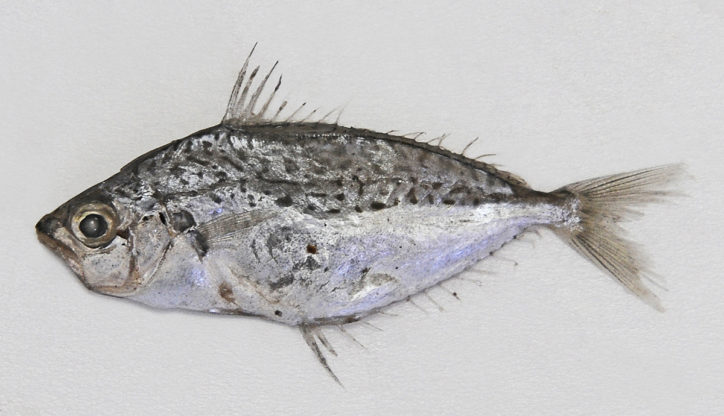
(Equulites klunzingeri. Photo © Marine Science and Fisheries Centre, Muscat. fishbase.org)
It inhabits the depths of up to 59 meters. The maximum recorded length is 11 cm. It feeds on bottom invertebrates. It entered the Mediterranean Sea through the Suez Canal from the Red Sea. It has been found several times in the Adriatic.
Oplegnathidae (knifejaws) is a small family of 7 fish species that inhabit the sea waters of South Africa, Australia, Peru, and Japan. Only one representative of the family has been found several times in the Adriatic Sea:
Barred knifejaw (Oplegnathus fasciatus).
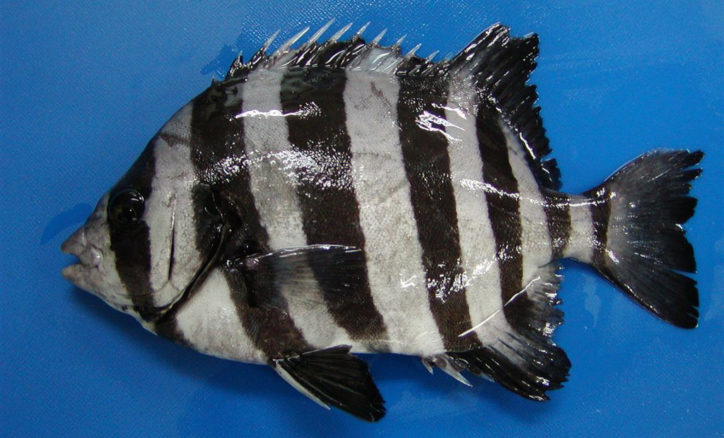
(Barred knifejaw. Photo © blogs.yahoo.co.jp/tak755)
It inhabits the depth of 1-10 meters. The maximum recorded length is 80 cm. The maximum weight is 6.4 kilograms. It feeds on crustaceans and mollusks. This inhabitant of the western part of the Pacific Ocean (waters of Japan, Korea, and Taiwan) was first discovered in the Mediterranean Sea, then, in 2015, it was caught by a local fisherman in the northern part of the Adriatic Sea (Trieste, Italy), and then in the Bay of Bakar in Croatia. Most likely, it penetrated from the Pacific Ocean along with the ballast water of the ships.
The Terapontidae (grunters or tigerperches) comprises about 60 fish species that inhabit the coastal tropical waters of the Indian Ocean and Western Pacific Ocean. Some species can be up to 80 centimeters long, but most of them don’t exceed 30 centimeters. Only one representative of the family has been found in the Adriatic Sea several times:
Largescaled terapon (Terapon theraps).

(Largescaled terapon. Photo by © John E. Randall. fishbase.org)
It inhabits the depth of up to 10 meters. Adult specimens swim close to the coast, often close to river mouths. The maximum recorded length is 30 cm. It feeds on invertebrates and small fish. It is the inhabitant of the Pacific Ocean. It has been found in the northern part of the Adriatic Sea (Piran, Slovenia) several times. It must have entered the Adriatic along with the ballast water of the ships.
Lobotidae (tripletails) is a tiny family of 2 fish species inhabiting most tropical seas. They are large, slow fish that feed on shellfish, shrimp, and fish. Only one representative of the family is found in the Adriatic Sea:
Tripletail (Lobotes surinamensis).

(Tripletail. Photo by © Hans Hillewaert. flickr.com/photos/bathyporeia)
It inhabits the depths of up to 70 meters. It prefers to swim in bays, estuaries with muddy water and river mouths. The maximum recorded length is 110 cm, specimens up to 80 cm are more common. The maximum weight is 19.2 kilograms. It feeds on bottom crustaceans and small fish. Small fish often swim near the surface and mimic leaves fallen to the surface. Lobotes surinamensis was first found In the Mediterranean Sea in the late 19th century. It was found in the Adriatic in 2010 for the first time.